I spent the last three months making a different pasta shape each week - here’s what I learned. When making homemade pasta, there are a few key elements required to understand to really nail the process: perfecting the dough, learning different shapes, and storing the pasta. In this guide, I will walk through each of these areas.

Over the last few years, I've scoured cookbooks, blogs, videos, and instructions to learn new pasta shapes. Along the way, I learned so much about the history and techniques of all of these interesting varieties!
Before we begin, I’d like to preface that there are hundreds, maybe even a thousand pasta shapes. I spent 3 months on this project, but others have spent decades doing so! Where possible, I provide additional links to resources if you’d like to learn from the masters.
- Perfecting the Dough
- Key Ingredients
- Kneading
- Dough Troubleshooting
- Rolling Out Egg Dough
- Rolling Out Semolina Dough
- Pasta Shapes: From Tagliatelle to Malloreddus
- Pici
- Cavatelli
- Malloreddus
- Orecchiette
- Ciciones
- Cecamariti
- Tagliatelle
- Pappardelle
- Farfalle
- Paccheri
- Ravioli
- Agnolotti
- How to Store Pasta
- Pairing Fresh Pasta
- Recipes & Resources
- Sauce Ideas
- References
Perfecting the Dough
What do we mean when we say we want to make great pasta dough? Depending on the type of dough, this could mean different things.
Fresh fettuccine, for example, is often silky, soft and smooth with a slight elastic quality. Ricotta gnocchi melts in your mouth, and should never be tough or chunky. Malloreddus has a really chewy, satisfying bite to it.
While each individual pasta shape has a rich history and unique textural profile, many shapes use the same base dough and technique.
Typically, there are 3 types of doughs:
Egg Yolk Dough
Fettuccine, pappardelle, farfalle, garganelli, and ravioli are all examples of pasta shapes using egg yolks. Some recipes use just egg yolks, while others use whole eggs (more on that later).
These also tend to be rolled out via a pasta maker or rolling pin into flattened sheets before cutting into individual shapes. Traditionally, these originated from Northern and some areas of Central Italy.
🧑🏽🍳 Recipe Suggestions: Homemade Pasta with a Kitchenaid and Egg Yolk Ravioli
Semolina Dough
Semolina/hard durum wheat dough: Orecchiette, malloreddus, and cavatelli are all examples of pasta shapes made with semolina/durum wheat flour. Most doughs are made with a 1:2 ratio of water to flour; no yolks are involved. Doughs need to be kneaded for at least 20 minutes to form enough gluten and yield a toothsome result. These doughs originated from Southern and some areas of Central Italy.
🧑🏽🍳 Recipe Suggestion: Semolina Pasta Dough
Potato/Ricotta Gnocchi Dough
Potato/ricotta gnocchi dough: Potato and ricotta gnocchis just barely come together with a bit of flour, with the potato/ricotta as the main star of the show. Sometimes, the dough is made with interesting ingredients such as sweet potato or goat cheese.
🧑🏽🍳 Recipe Suggestions: homemade potato gnocchi and ricotta gnocchi
There are many, many other pasta shapes that don’t follow the categorization above. Some fall in between, and include both egg yolks and semolina, while others are much more batter-like. In this guide, I will be focused most heavily on the most popular pasta shapes for egg and semolina doughs.
Key Ingredients
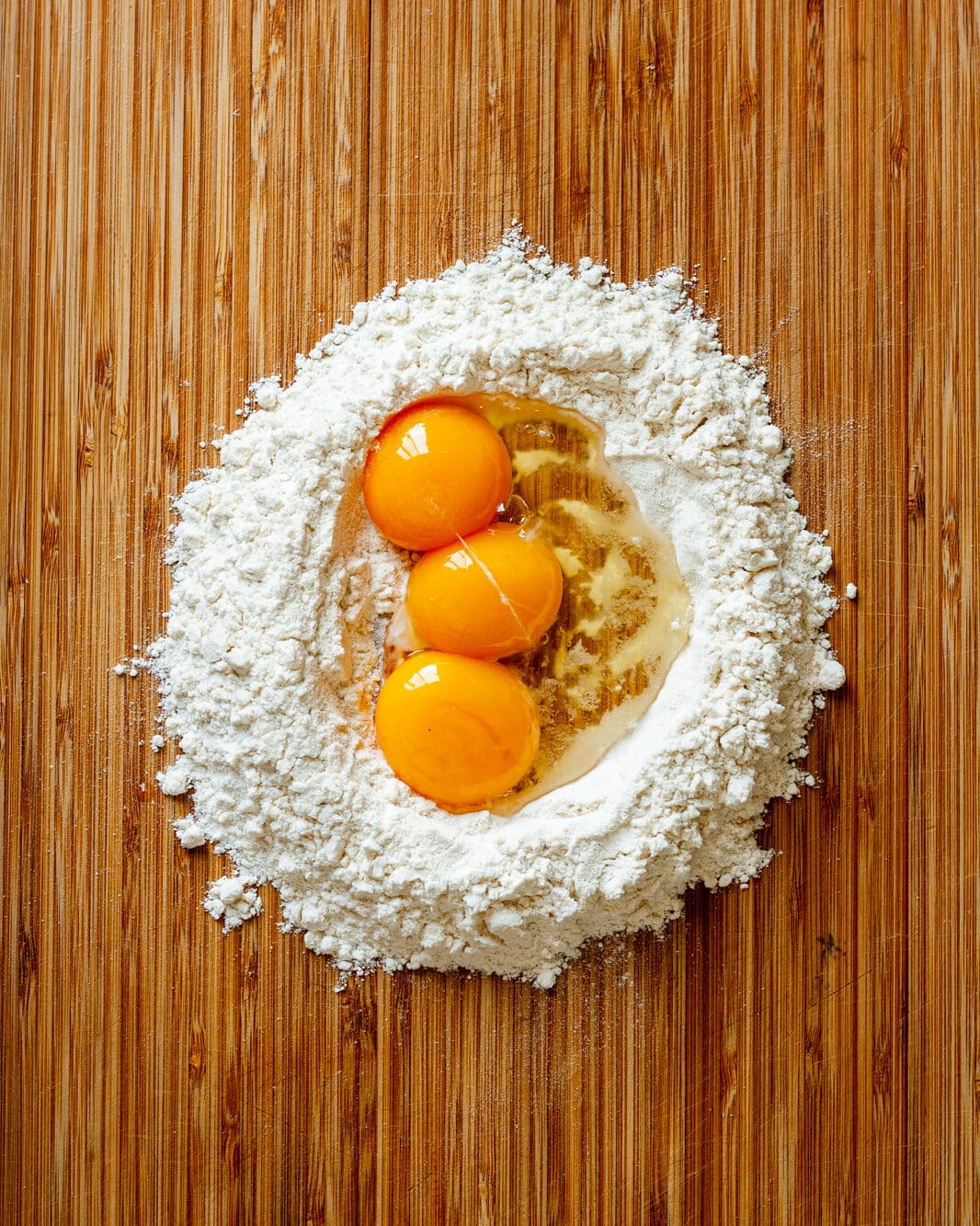
Flour. Flour is a vital component to pasta making. Kneading flour with a liquid (eggs or water) allows gluten to form from the proteins in the flour. This gluten formation creates the characteristic slightly stretchy, elastic texture in pasta.
There are two main types of flours used in pasta making: a softer, lower protein flour and harder, higher protein flour.
According to Marc Vetri in Mastering Pasta, soft flours provide elasticity, or stretch, while harder flours create more plasticity to ensure shapes stay in place. Soft flours are used in the typical egg yolk doughs — think of that subtle, stretchy/springiness in fettuccine, while hard flours help create shapes in semolina doughs, like orecchiette.
But we can also think outside of the box. Play around with adding 10%, 20% or 30% hard flours to a soft flour egg yolk dough and see what happens. As long as you have an understanding of when and why you’d want to use a lower vs. higher protein flour, you can experiment with different combinations of the two and different combinations of different flours.
Flour Types:
- 00 Flour: Most people use Italian 00 flour for their pasta — the “00” annotation refers to the fineness of the flour when milled, which helps ensure that the pasta can easily slide through the rollers. 00 is the most finely milled flour in Italy and considered a softer wheat flour (so lower protein).
- Semolina Flour: This is made by milling durum flour, a harder wheat flour with higher protein and a characteristic pale yellow color. Because of its coarser nature, it’s most often used to keep pasta from sticking to itself. Some pasta recipes may call for semolina, but most will call for a finer ground (durum wheat or semola rimacinata).
- Durum Wheat Flour / Semola Rimacinata: This flour is made by grinding semolina even further into a finer ground. Generally, durum wheat flour is used interchangeably with semola rimacinata. In addition to being higher protein, this flour also has a slightly rougher texture, allowing sauces to get trapped and cling to the noodles.
In summary: The most important thing with flour for pasta making is understanding what type you need for the particular shape you’re making. Do you want a more stretchy pasta?
Do you want the pasta to hold its shape? If your sauce is heartier, you might want a more chewy shape; if lighter, you may want a softer dough.
Eggs. For egg doughs, If I can afford to, I always try to use high quality eggs in my pasta as I feel it really adds to the richness and luxuriousness of the dough. I’ve made doughs with just egg yolks and doughs with egg yolks and whole eggs.
I personally prefer an all egg-yolk dough or a higher ratio of egg yolks to whole eggs. Egg yolks add richness and a bit more firmness because of their protein, while whole eggs are more watery.
A firmer dough also means it’s harder to roll thinner, so depending on the type of pasta you’re making you may want to replace the egg yolks with more eggs.
Olive Oil. Some pasta doughs will utilize olive oil, which adds moisture and makes it a bit easier to roll out the dough.
Kneading
Once you have the ingredients measured out to make your dough (see the recipes and resources section for recipes), you’re ready to make the dough.
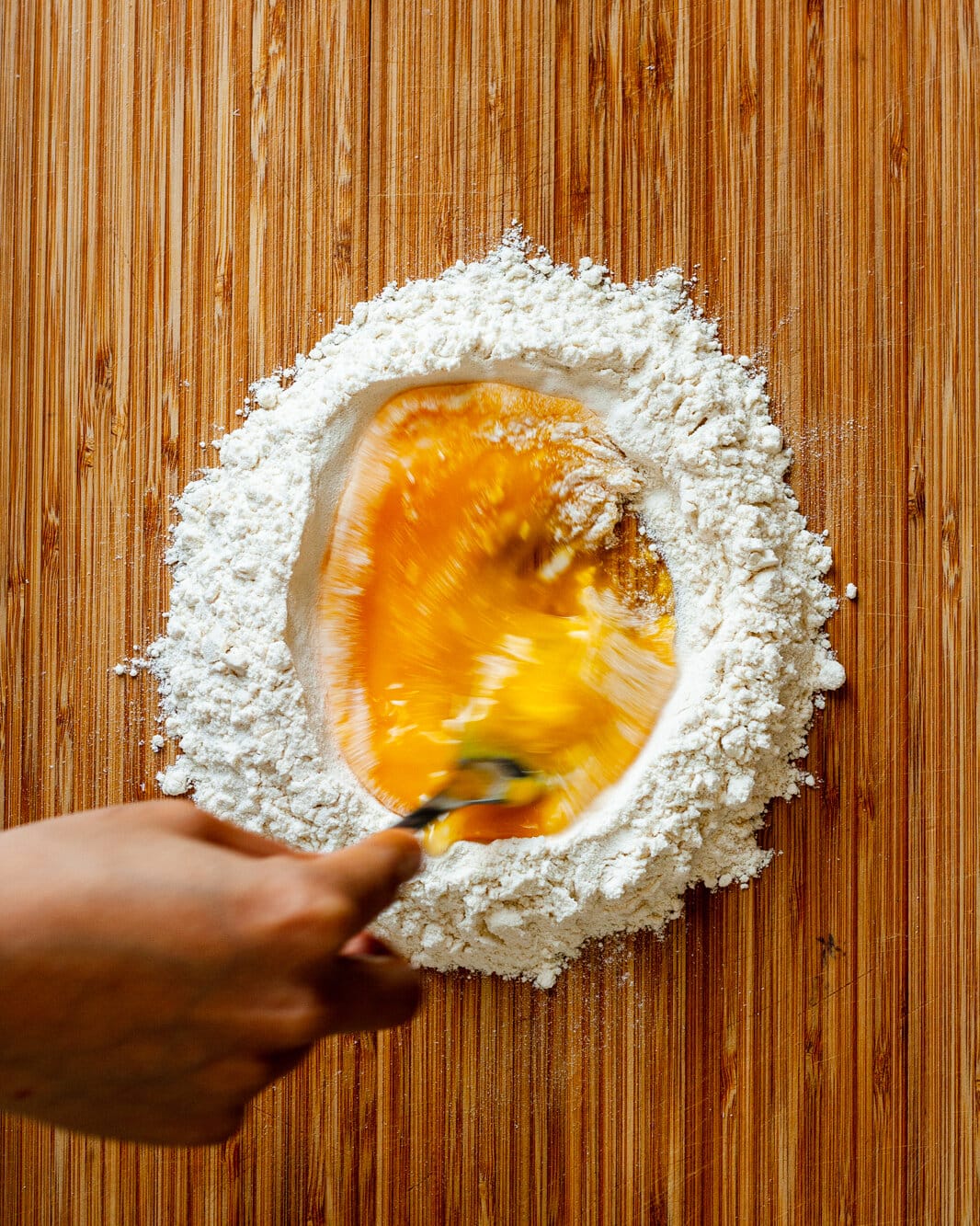
- Measure out your flour onto a cutting board or large wooden work surface.
- Make a well with your fingers in the center of the flour, then widen it. You’re looking for a wide, almost crater-like well so that the eggs do not spill over the top.
- Slowly add eggs, one at a time into the well. If you notice the well isn’t tall or wide enough, you can continue to adjust. For beginners, I recommend building your well in a large bowl to avoid a mess (in case the eggs break). Add olive oil and salt if using.
- Using a fork, poke the eggs and whisk them until homogenous.
- Slowly begin mixing some of the surrounding flour into the well, being careful not to break it. If you do happen to break the well, it’s totally fine — it’ll just make it slightly harder to get a homogenous dough ball as quickly.
- Begin incorporating more and more of the flour into the well, whisking with the fork until the liquid in the well starts thickening. Once it becomes thick and solid, place the fork down and begin kneading with your hands.
- Alternate between incorporating more of the remaining flour and kneading the dough. A bench scraper is a helpful tool to pick up any of those scraggly bits from the work surface as well as your own hands.
- Once in a solid mass, I like to knead with both my hands then rotate the dough counter clockwise at 45 degrees. Continue repeating until the dough is soft and smooth, about 5-7 minutes. It should not feel sticky, and there should be no dry bits remaining.
- Tip: When watching Evan Funke, a master pastaio, he noted that once your pasta is in a solid ball, it takes much more effort to smoothly incorporate small scraggly bits into the dough. If there are a few bits leftover, just move them to the side and continue kneading the rest of the dough.
- Wrap tightly in plastic wrap.
- Let the dough rest for at least 20 minutes before rolling out. You can keep it in the fridge, wrapped tightly, for 1-2 days but I prefer to roll it out the same day.
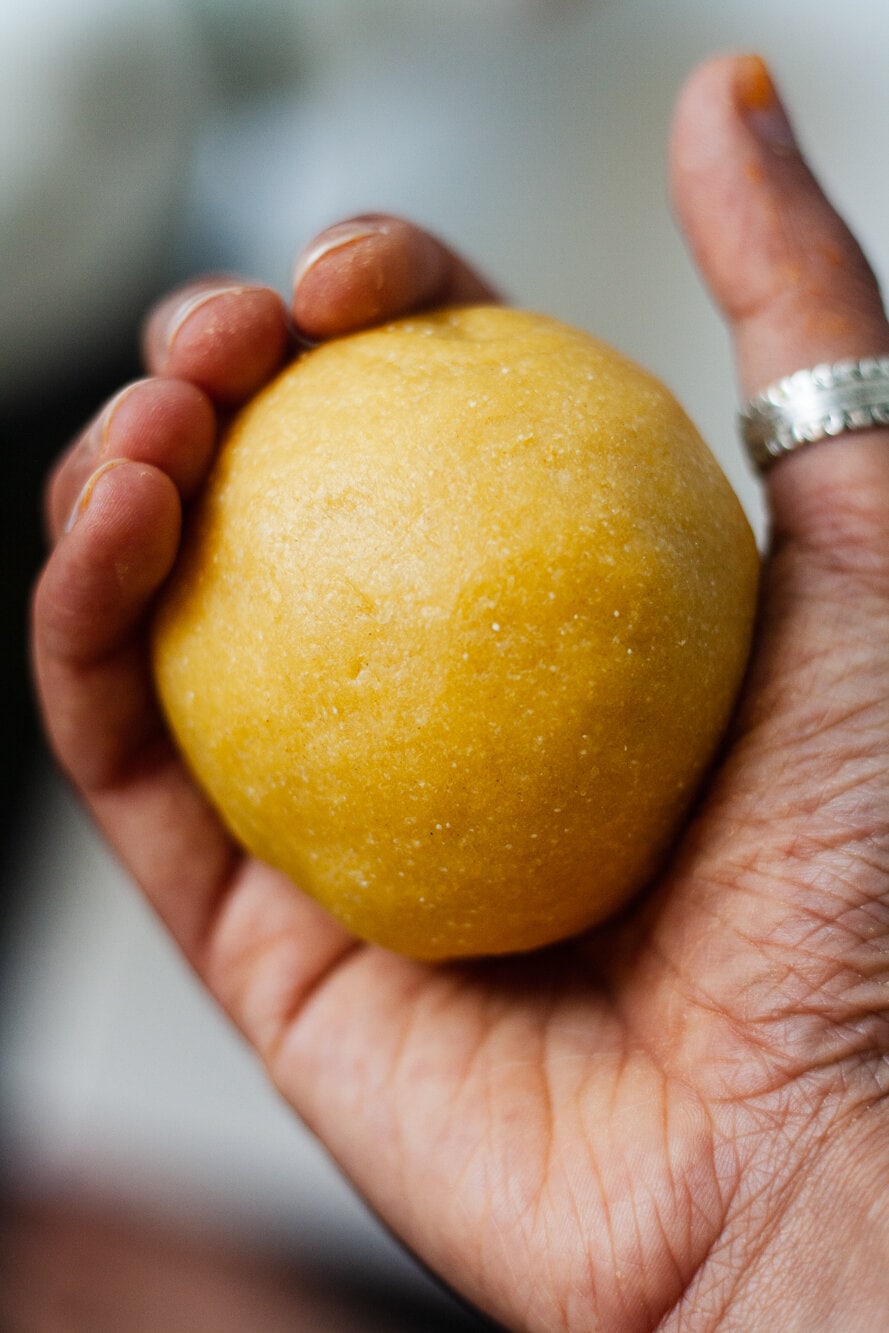
Dough Troubleshooting
Sprinkle a small amount (the key is small! ~1 tsp) of flour at a time while kneading until the dough becomes more manageable.
Sprinkle a small amount (the key is small! ~1 tsp) of water at a time while kneading until the dough becomes more manageable. If you have a spray bottle, that works well.
And note, dry bits are different from your overall dough being too dry. If you have small dry bits, and you’re at the beginning of the kneading phase, they may very well get incorporated. If you’ve been kneading for a while, you can scrape those bits off and set them aside.
How do I know when my dough is done kneading?
You will be able to get the hang of this the more you practice. In general, for both types of pasta, the dough ball will be quite smooth — there shouldn’t be any dry bits on the surface and and it shouldn’t be sticky. For semolina dough, you’ll want to knead quite a bit longer to build up a gluten network.
For egg dough, sprinkle a little flour or cornstarch on top of the dough for passing through the rollers. If it’s really sticky, you’ll need to re-knead the dough with more flour and let rest again before attempting to roll out.
For semolina dough, if it’s a little bit sticky it’s okay — this dough dries out really easily as you’re making shapes, so it may still be workable. If very sticky, you’ll need to do the same method as the egg dough above.
What’s considered a high vs. low protein flour?
High protein is generally classified 10% - 14% while lower protein flour is typically 5% - 10%. All Purpose Flour (AP) is typically in the 10% - 12% range, while bread flour is 12% - 14%.
Tip: King Arthur Flour’s AP is higher protein content than other AP flours at 11.7%.
Rolling Out Egg Dough
- For four servings (about 1 lb of pasta dough), you’ll want to divide the ball into four equal sections.
- Take one section out, leaving the rest in plastic wrap. Roll out the section of dough until it’s ⅓” thick.
- If using a pasta maker, feed the dough into the widest setting (#1) twice. The dough will likely be in an oval shape. To make a uniform rectangle, fold one end halfway up the dough, then fold the other end on top so you’ll have three even layers. Roll the dough out to ¼” thickness.
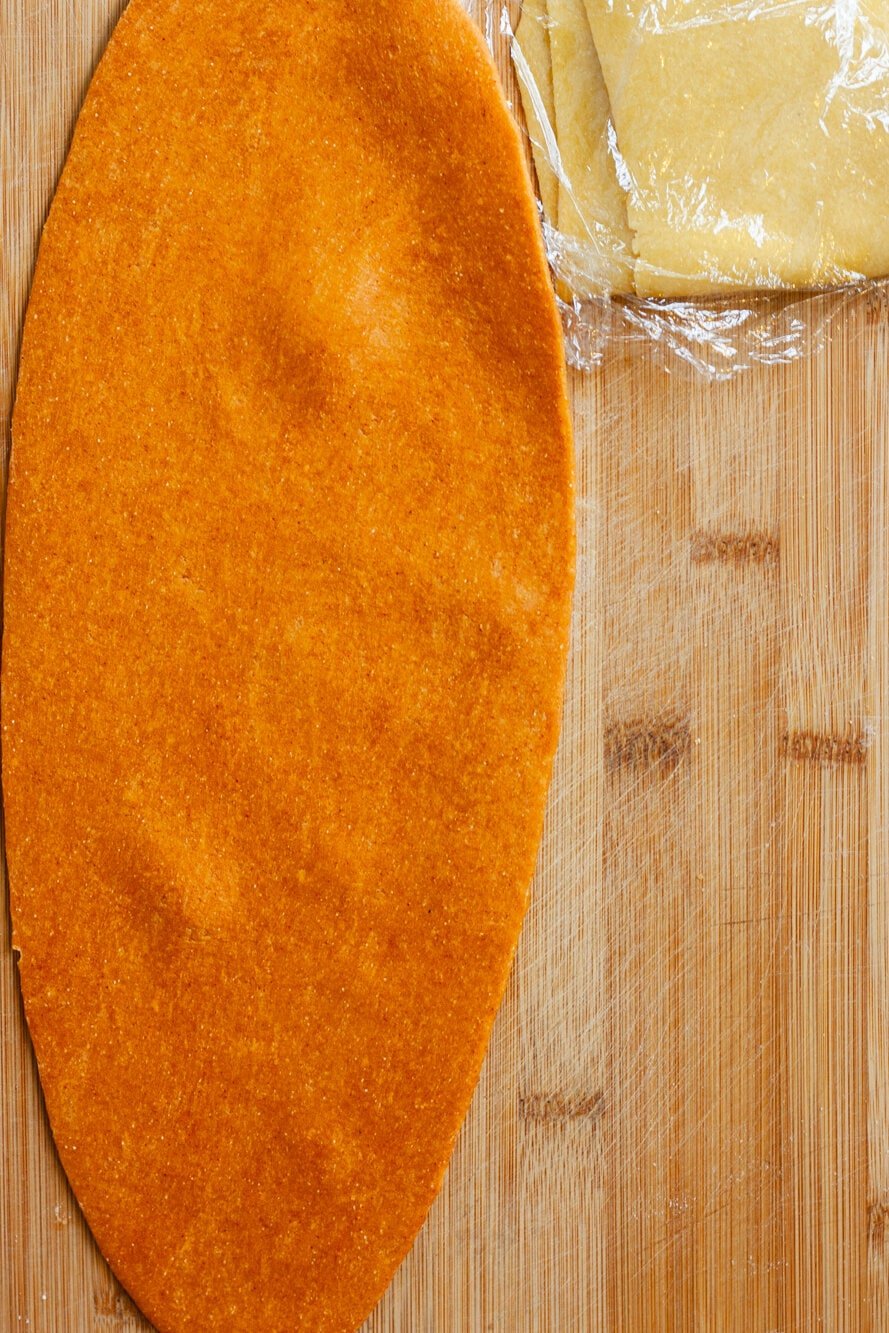
Feed the dough through the next highest setting (#2) twice, then continue feeding through narrower and narrower settings until you’ve reached the thinness required.
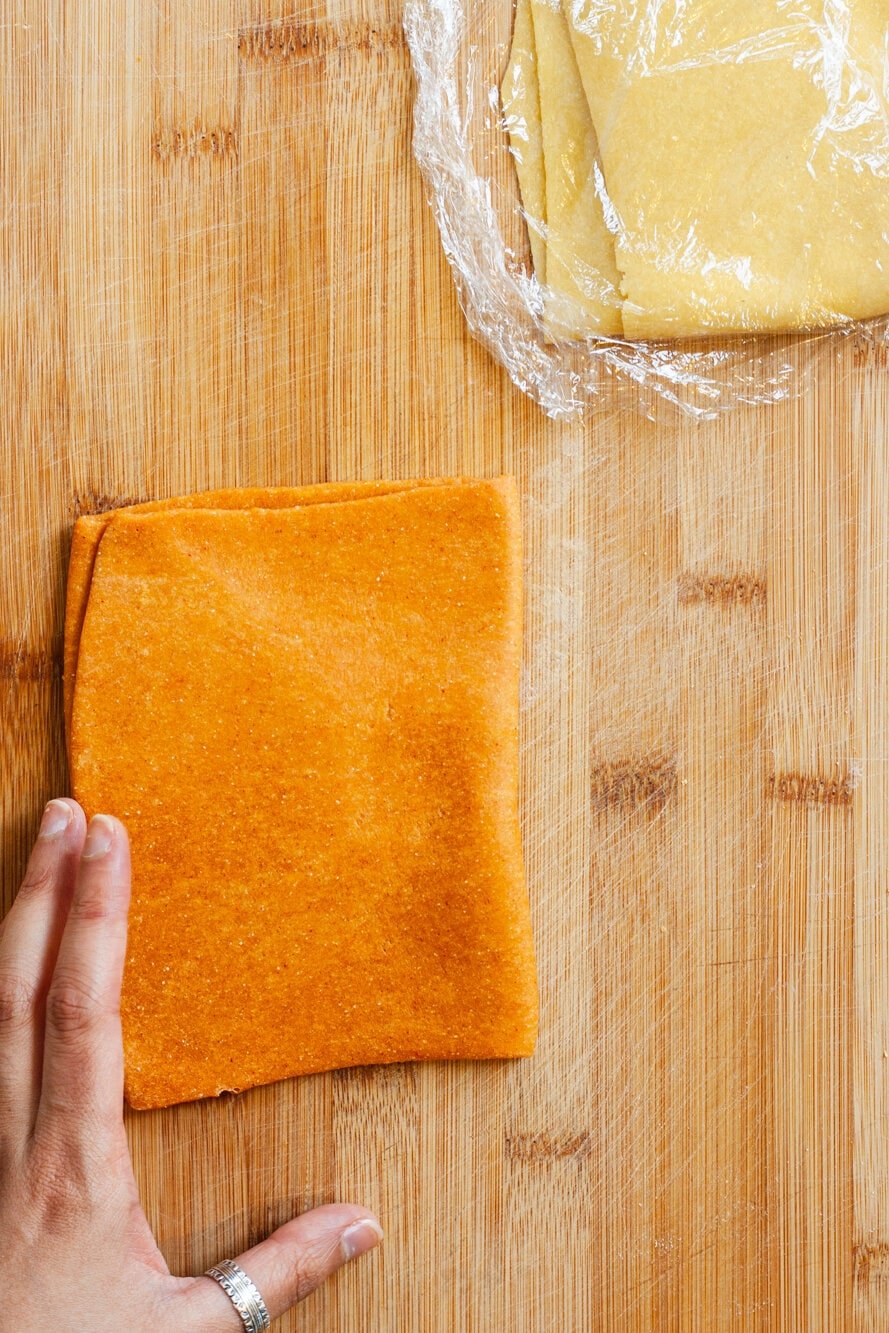
Once the dough is at the right thickness, you can proceed to cutting and forming the desired shape. If the dough is sticking to the rollers, you can sprinkle a bit of flour on it.
4. If rolling egg pasta pasta by hand, I highly recommend referring to American Sfoglino by Evan Funke. I personally don’t roll my pasta by hand, but I hope to one day. While you can still make great pasta with a machine, hand rolled pasta imparts additional texture to the dough for sauce to cling to.
Rolling Out Semolina Dough
- Typically, most shapes made from this type of dough involve breaking off a chunk of dough at a time (usually about 2” wide), rolling it into a thin rope (between ¼” to ½” diameter), then cutting the rope into ¼” to 1” pieces and shaping. Each recipe is different, but the process of rolling and then cutting is generally the same.
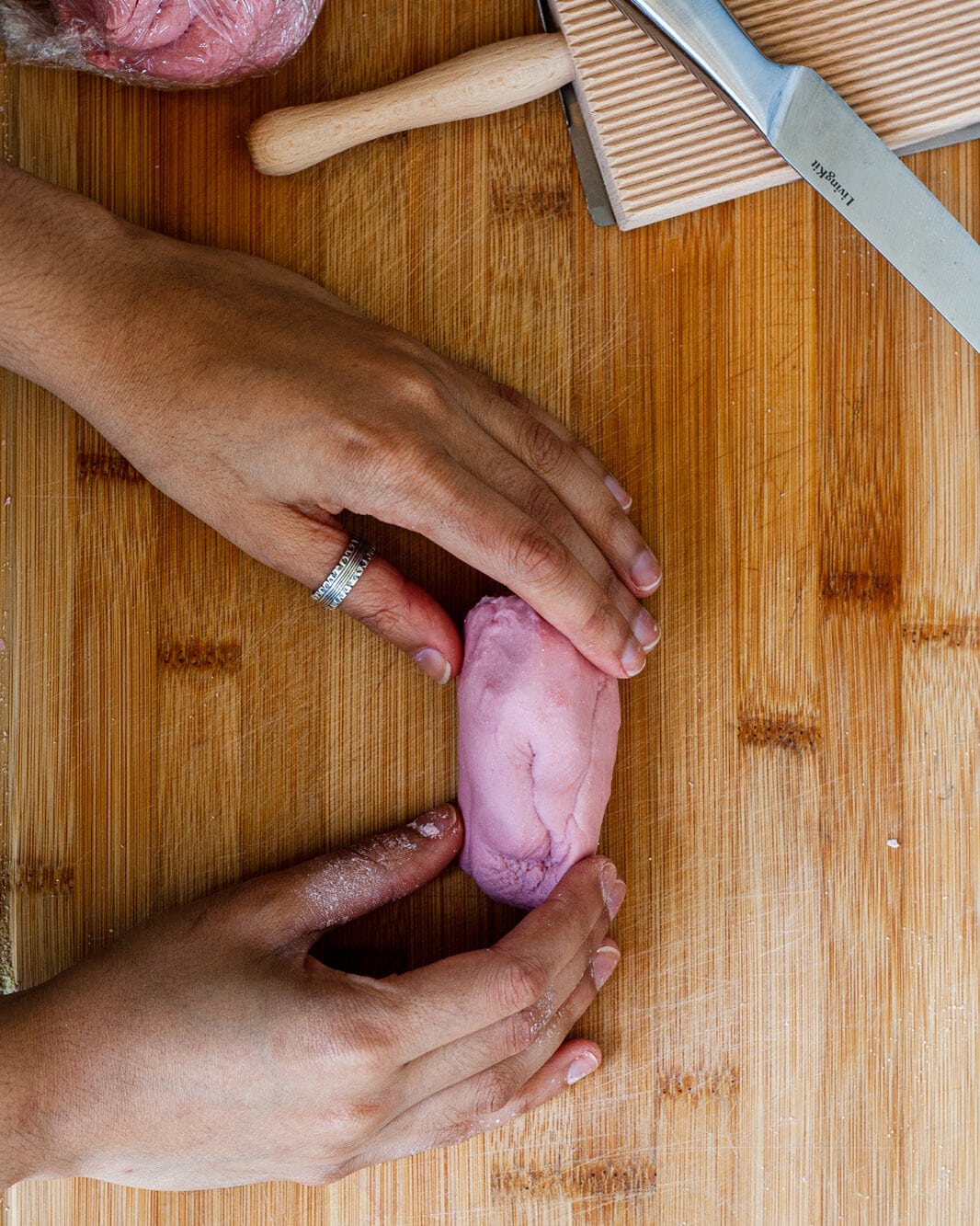
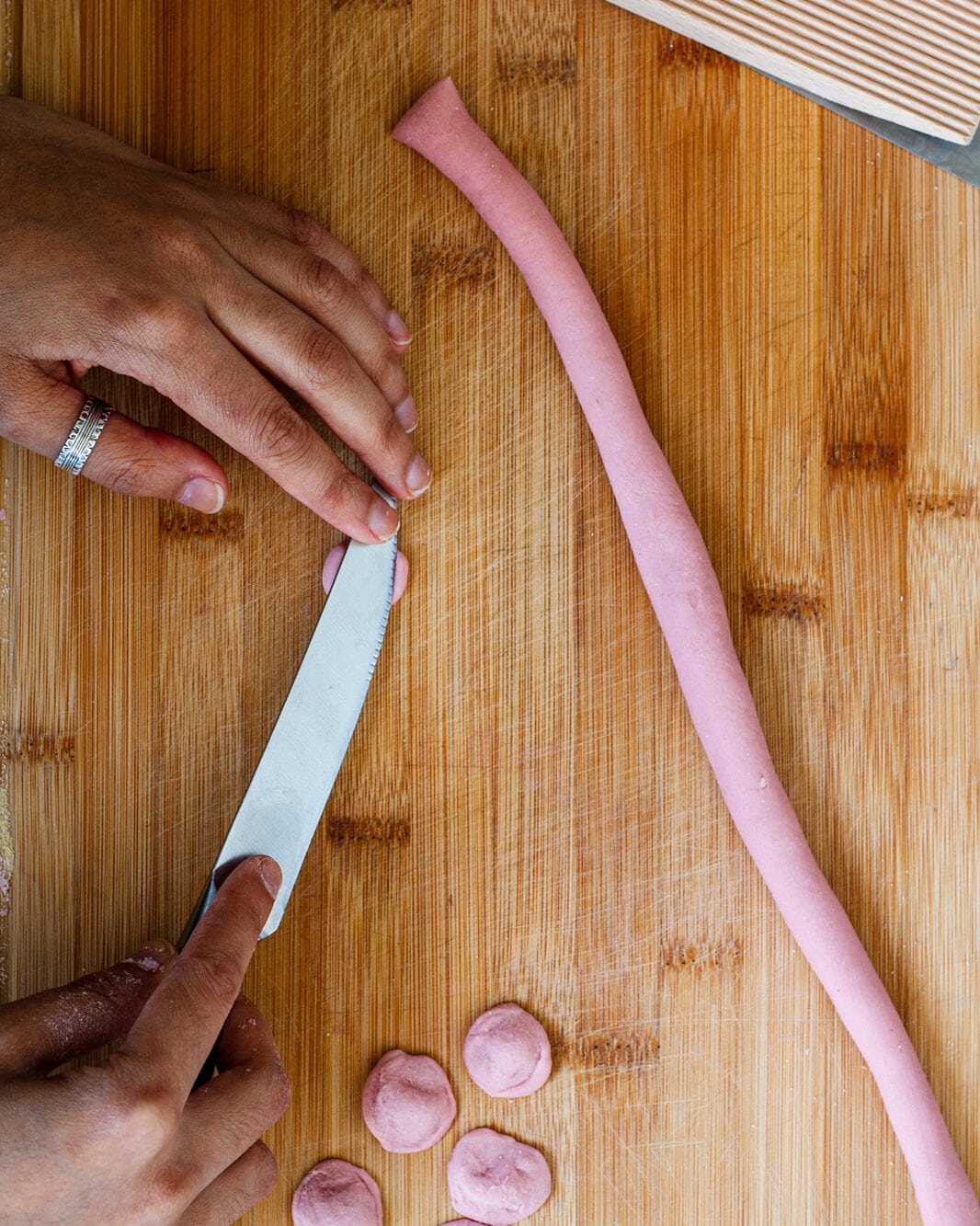
Tip: When rolling out dough, spread your fingertips wide and roll with your palms outward to stretch the rope.
Pasta Shapes: From Tagliatelle to Malloreddus
Now that you’ve prepped the dough, you’re ready to move on to making the individual shapes. For each shape, I’ve included a bit of information on the history, a brief technique, and suggested pairings.
Note: There are many different types of pasta shapes, and we'll just be covering a few of my favorite ones.
See my easy-to-view spreadsheet with all pasta shapes listed, their origins, and pairings.
Pici

Long, pencil-like strands of chewy goodness
Dough: Durum wheat/00 Flour/Water or 00 Flour/Water; sometimes oil
Technique: Roll dough into thin sheet, then cut into sections and roll each section into thick, spaghetti-like strands
Difficulty: Easy
Region/Origin: Tuscany; similar pastas made in Umbria, Lazio, Siena
Special Equipment: None
Traditional Pairings: Boar ragu; tomato and garlic sauce; pancetta and bread crumbs
Full Method & Recipe: Homemade Pici Pasta
Cavatelli

Small, hot-dog shaped pieces of pasta, sometimes ridged using a gnocchi board
Dough: Durum wheat, used to be made with fava bean flour in the south. Cavatelli can also be used as a generic term to describe pasta drawn across a gnocchi board and indented; some cavatelli dough can include ricotta or squash
Technique: Roll dough into a rope, then cut into ¾" - 1" pieces. Drag a knife across each piece to curl it over into hot dog shape. Create texture using a gnocchi board, strainer, or cheese grater.
Difficulty: Easy/Medium
Region/Origin: Campania, Puglia, Sicily, Calabria, and Basilicata
Special Equipment: Gnocchi board (or strainer or cheese grater -- anything with texture)
Traditional Pairings: Lamb ragu, tomato sauce; meat and vegetable sauces; broccoli rabe and white sauce; often served with chilies
Full Method & Recipe: Pasta by Hand (by Jenn Louis)
Malloreddus

Small, ridged pasta similar to cavatelli but made with saffron and originating in Sardinia
Dough: Durum wheat, saffron, water
Technique: Roll dough into a rope, then cut into ½" pieces. Drag a knife across each piece to curl it over into hot dog shape. Create texture using a gnocchi board, strainer, or cheese grater
Difficulty: Easy/Medium
Region/Origin: Sardinia
Special Equipment: Gnocchi board (or strainer or cheese grater -- anything with texture)
Traditional Pairings: Ragu, tomato sauce
Full Method & Recipe: Malloreddus with Tomato Butter Sauce
Orecchiette

A pasta shape meaning “little ears”, these are textured from dragging a knife against small pieces of dough then inverting on your thumb.
Dough: Durum wheat, sometimes whole wheat flour, water
Technique: Roll dough into a rope, then cut into ¼" - ½" pieces. Drag a knife across each piece to curl it over into hot dog shape then invert on your thumb.
Difficulty: Medium
Region/Origin: Puglia
Special Equipment: None
Traditional Pairings: Broccoli rabe / rapini, sausage, and chili flakes; sometimes mushrooms
Full Method & Recipe: Homemade Orecchiette
Ciciones

Small, chickpea-like dumplings with Saffron from Sardinia
Dough: Durum wheat, saffron, water
Technique: Roll dough into a rope, then cut into ¼" pieces. Roll each piece into a spherical ball to mimic chickpeas.
Difficulty: Medium
Region/Origin: Sardinia
Special Equipment: None
Traditional Pairings: Meat sauce and pecorino
Full Method & Recipe: Pasta by Hand (by Jenn Louis)
Cecamariti

Small pieces of raised (yeasted) bread dough shaped into pasta
Dough: Wheat flour, yeast/sourdough, water
Technique: Roll dough into a rope, then cut into ½" pieces. Roll each piece with your fingers to create a wider center and tapered ends.
Difficulty: Easy
Region/Origin: Lazio and Molise
Special Equipment: None
Traditional Pairings: Raw garlic + chili; tomato sauce
Full Method & Recipe: Briciole
Tagliatelle

Classic ribbons of egg dough
Dough: Egg
Technique: Fold and cut pasta sheets into ¼" strips
Difficulty: Easy
Region/Origin: Bologna, but also widespread
Special Equipment: Pasta machine or by hand
Traditional Pairings: Varying by region, but bolognese is very common in Bologna; sausage and peas in the countryside
Full Method & Recipe: Homemade Pasta (Kitchenaid)
Pappardelle
Dough: Egg
Technique: Fold and cut pasta sheets into 1" strips
Difficulty: Easy
Region/Origin: Emilia-Romagna, the Marche, Umbria, Tuscany, Abruzzo
Special Equipment: Pasta machine or by hand
Traditional Pairings: Ragu
Full Method & Recipe: Homemade Pappardelle Pasta
Farfalle

Dough: Egg
Technique: Cut pasta sheets into 2" x 1" squares then pinch middles to form butterfly shape
Difficulty: Medium
Region/Origin: Throughout
Special Equipment: Pasta machine or by hand; ravioli/fluted cutter
Traditional Pairings: Varies by region; I love it with prosciutto and peas
Full Method & Recipe: Mastering Pasta (by Marc Vetri)
Paccheri
Tube-shaped pasta, sometimes stuffed with cheeses or meats
Dough: Egg, Durum wheat flour and water for factory made
Technique: Cut pasta sheets into rectangles then seal one end over the other to form a tubular shape
Difficulty: Medium
Region/Origin: Campania / Southern Italy
Special Equipment: Pasta machine or by hand
Traditional Pairings: Varies by region; sometimes stuffed with sausage and garlic, or mushrooms in a white wine sauce; sometimes bolognese
Full Method & Recipe: The Pasta Project
Ravioli
Classic circular or square-shaped stuffed pasta
Dough: Egg
Technique: Divide pasta sheet in half and mark circles or squares on one half. Spoon filling into each circle/square, then fold the other half over. Press the filling then cut out each circle/square.
Difficulty: Medium
Region/Origin: Throughout
Special Equipment: Pasta machine or by hand; ravioli cutter or press
Traditional Pairings: Varies by region, but typically stuffed with ricotta and greens or meat
Full Method & Recipe: Mastering Pasta (by Marc Vetri)
Agnolotti
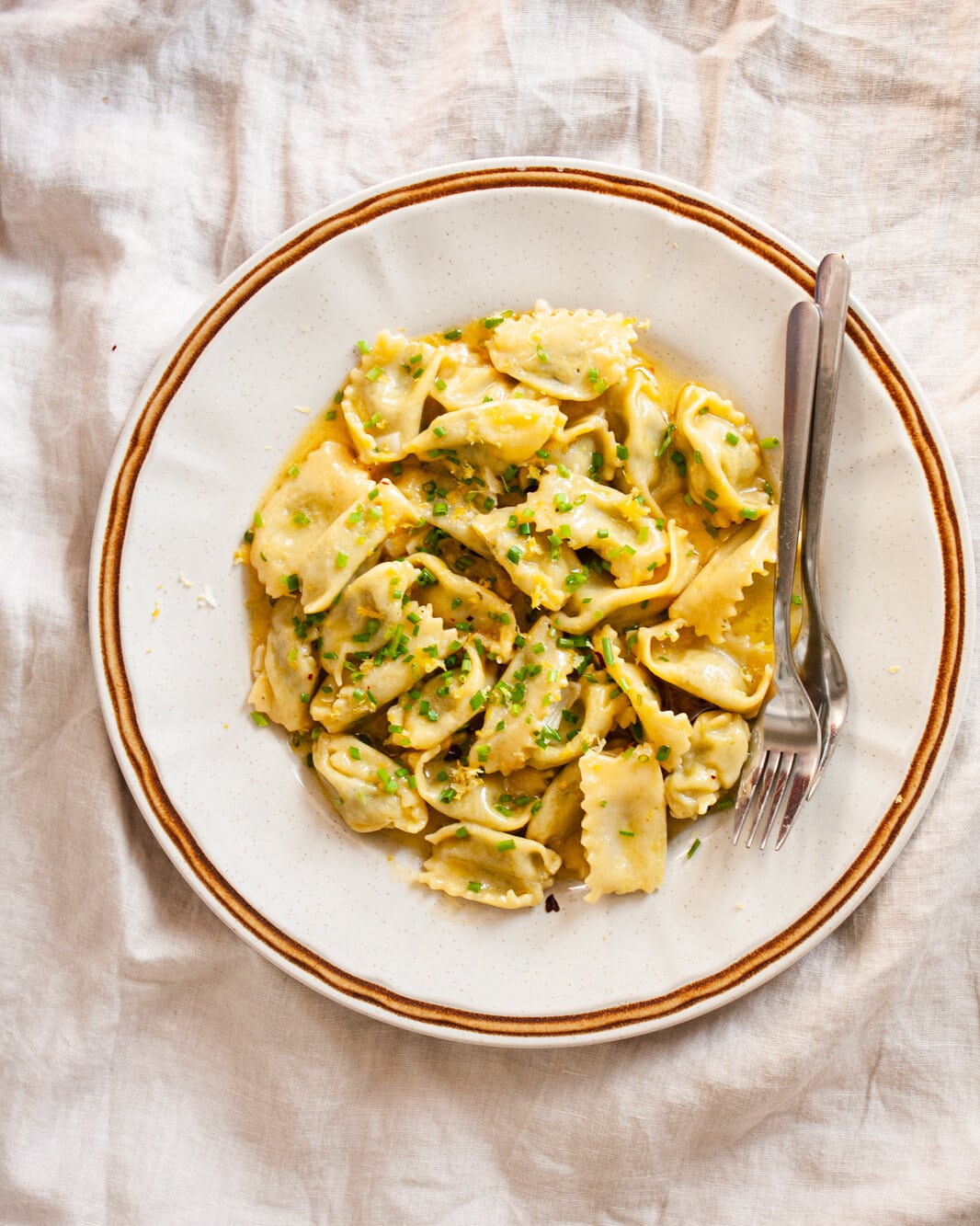
Small, pinched pouches of dough stuffed with delicious fillings
Dough: Egg
Technique: Divide pasta sheet in half and spoon small amounts of filling across one side; fold the other side over and pinch to seal, then run a cutter across the sealed edge. Cut into individual squares or rectangles, depending on the type of agnolotti.
Difficulty: Medium/Hard
Region/Origin: Langhe, Tuscany
Special Equipment: Pasta machine or by hand; ravioli / fluted cutter
Traditional Pairings: Varies by region, but typically stuffed with meat or cheese
Full Method & Recipe: Agnolotti del Plin (by Eataly)
How to Store Pasta
Okay, so you’ve learned how to knead, roll and shape your pasta. Often times, you’ll make a larger batch of pasta that’s not possible to eat in one sitting, so it’s helpful to understand how best to store any extras.
Check out my guide on how to storing fresh pasta for more details!
Pairing Fresh Pasta
In addition to the pairing suggestions above, there are a few general suggestions in terms of what sauces go well with what pastas.
- Light sauces (butter and cream sauces) tend to go well with egg pasta doughs, such as tagliatelle or stuffed pastas.
- Heavier sauces (meat sauces and ragus) tend to stand up well to the chewy, bitey durum wheat doughs.
- Pastas with lots of nooks and crannies are great for holding sauces, sausages, or vegetables - for example, orecchiette pair well with sausage or even peas because the pasta can ‘cup’ the other ingredients.
- That being said, there are always exceptions. Many ravioli dishes are served with tomato sauce. Tagliatelle and pappardelle are often served with meaty ragus. Some of the pairings are based on tradition, while others are based on pairing an ideal texture with an ideal sauce.
- I recommend experimenting while keeping in mind the traditions and asking yourself the question “Why did they pair it this way? Did this pasta hold up better to this sauce?”
Recipes & Resources
To get started on your pasta making, you’ll need a base recipe, as well as some sauce suggestions. As stated previously, treat these as guidelines.
There are so many factors that can impact how your dough turns out — the humidity in the day, the size of your eggs, the fineness of your flour etc. I recommend starting with a base and adjusting based on what feels right to you.
Remember, at the end of the day you’re looking for a perfectly smooth, resilient dough after kneading.
I’ve spent hours reading and re-reading recipes and instructions from experts, so for each recipe section, I’ve also provided a number of resources I found helpful.
Recipe: Egg Pasta Dough
Recipe: Semolina Dough
This recipe teaches you how to make various fresh pasta shapes, including tagliatelle, pappardelle, and spaghetti.
Additional resources:
Sauce Ideas
I created the following flavor matrix below as a means of helping you pick a delicious sauce based on what you had in your pantry. To download the matrix, you can click on the image.

For additional information on pairings, as well as a list of 30+ sauce recipes, see my other post on how to cook great pasta.



